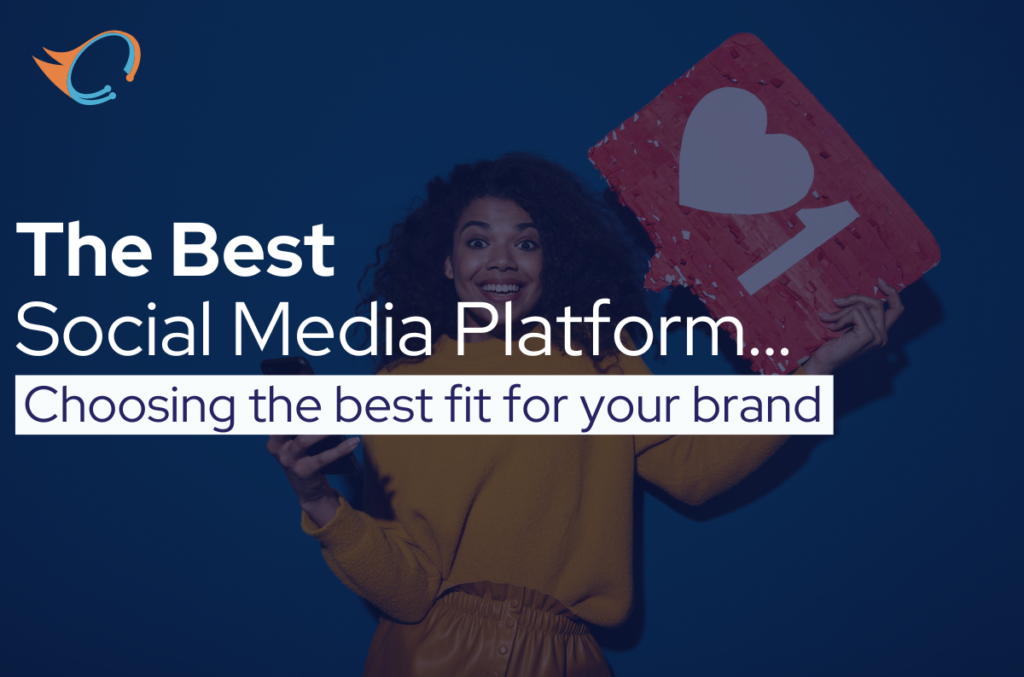
In today’s digital age, the question of what social media platform best aligns with your brand’s voice is more crucial than ever. With a myriad of platforms at our fingertips, each offering unique avenues for engagement and storytelling, selecting the right one can make or break your brand’s online presence. This choice goes beyond mere preference; it’s about finding a space where your brand’s personality resonates with an audience eager to listen, engage, and convert. This article dives deep into the heart of matching your brand’s unique voice with the perfect social media platform. From understanding the nuances of your brand’s identity to analyzing the demographic tapestry of each platform, we’ll guide you through a strategic approach to ensure your brand not only speaks but is heard loud and clear. Whether you’re a visual storyteller eyeing Instagram’s colorful canvas or a witty wordsmith looking to capture Twitter’s fast-paced audience, we’ve got you covered. Join us as we explore how to amplify your brand’s voice, ensuring it reaches the right ears, on the right platform. Discover the key to unlocking your brand’s social media success and why knowing what social media platform to use is the cornerstone of digital marketing strategy.
Understanding Your Brand’s Voice
Before diving into the vast sea of social media to decide what social media platform best suits your brand, it’s imperative to first anchor down your brand’s voice. This foundational step is crucial because your brand’s voice is not just about how you communicate; it’s about who you are in the digital world. It embodies your values, your brand’s personality, and how you connect emotionally with your audience. Whether your tone is professional, playful, inspirational, or informative, it should consistently reflect across all content you share online.
Identifying and understanding your brand’s voice involves a deep dive into what your brand stands for, its mission, and the values it wishes to communicate. This introspection helps in creating a voice that resonates with your target audience, making your brand relatable and memorable. For instance, a brand with a youthful, energetic voice might find its home on TikTok or Instagram, where creativity and vibrancy thrive. Conversely, a brand that leans towards a professional, informative tone might gravitate towards LinkedIn.
The alignment of your brand’s voice with the chosen social media platform is pivotal. It ensures that your messaging not only reaches the right audience but also engages them in a meaningful way. This strategic alignment is where the question of what social media platform becomes more than a choice—it becomes a decision that can significantly influence your brand’s online trajectory.
Moreover, incorporating secondary keywords such as brand identity and marketing strategy into your analysis can further refine your understanding of how your brand’s voice should shape its social media presence. Your brand’s identity, inclusive of its voice, should inform every aspect of your marketing strategy, guiding which platforms will best amplify your message and engage your target demographic.
Understanding your brand’s voice is the first critical step in the journey to selecting the right social media platform. It’s about more than just where you speak; it’s about ensuring your voice is heard, understood, and valued by the right audience. As we explore further, keep in mind that the essence of what social media platform is best for your brand hinges on a deep understanding of your own brand’s voice and how it can best resonate in the digital sphere.
Overview of Major Social Media Platforms
When contemplating what social media platform will best broadcast your brand’s voice, a comprehensive understanding of the landscape is indispensable. Each platform boasts its unique culture, user base, and engagement style, making some more suitable for your brand than others. Let’s navigate through the major social media platforms to shed light on their core characteristics and audience demographics.
Facebook: As one of the largest and most diverse social media platforms, Facebook caters to a broad audience. It’s a versatile space for brands aiming to build community, share detailed content, and engage through both organic and paid strategies. Ideal for storytelling and community engagement, Facebook allows brands to connect on a personal level with their audience through posts, comments, and groups.
Instagram: Instagram’s visually driven platform is perfect for brands with a strong visual identity. It appeals to a younger, image-conscious audience that values aesthetics, storytelling through visuals, and creative content. Instagram Stories and Reels offer dynamic ways to engage users with short-form video content, making it a haven for brands looking to showcase their personality and flair.
Twitter: Known for its fast-paced nature and character limit, Twitter is the go-to platform for brands that excel in real-time engagement, topical content, and witty banter. It’s particularly effective for news-oriented brands, thought leaders, and those looking to engage in conversations around trending topics.
LinkedIn: With a focus on professional networking, LinkedIn is the premier platform for B2B brands, industry thought leaders, and businesses looking to share insightful content. It’s an ideal space for professional development, industry news, and in-depth discussions, appealing to a more mature audience of professionals and decision-makers.
TikTok: The newest player in the social media game, TikTok, has quickly become a powerhouse for creative, trend-driven content. It’s particularly appealing to younger audiences who favor authentic, entertaining, and innovative short-form videos. Brands with a knack for jumping on trends and creating viral content can find a highly engaged audience here.
Pinterest: Pinterest stands out as a unique platform that thrives on discovery and inspiration. It’s a visual bookmarking tool where users create and manage personal boards, pinning content ranging from DIY projects and recipes to fashion and home decor. For brands with a strong visual element and those in the lifestyle, retail, and creative sectors, Pinterest offers a unique opportunity to drive traffic to their websites through high-intent users. The platform’s demographic skews towards a predominantly female audience, making it an ideal space for brands targeting this segment with aspirational, instructional, and product-focused content.
Understanding the nuances of each platform is crucial in answering the question of what social media platform aligns with your brand’s voice. Whether your brand thrives on visual storytelling, professional insights, or engaging conversations, there’s a platform tailored to your communication style. By aligning your brand’s voice with the right platform, you can maximize engagement, reach your target audience more effectively, and build a lasting online presence.
Matching Platforms to Brand Voice
Once you’ve grasped the essence of your brand’s voice and have familiarized yourself with the major social media platforms, the pivotal task is to discern what social media platform aligns perfectly with your brand’s identity. This alignment is crucial for ensuring your message not only reaches its intended audience but resonates with them on a deeper level. Let’s explore how to match your brand’s voice with the right platform, optimizing for engagement and authenticity.
Facebook: Ideal for brands that prioritize community building and value long-form content. If your brand’s voice is conversational and aims to foster a sense of belonging among your audience, Facebook’s diverse tools for engagement—such as groups, live videos, and detailed posts—can help you create a vibrant community around your brand.
Instagram: For brands with a visually appealing story to tell, Instagram is your canvas. Whether your voice is inspirational, aspirational, or product-focused, Instagram’s visual and video formats (posts, stories, IGTV, Reels) allow you to weave your narrative in a way that captivates visually oriented audiences.
Twitter: If brevity and timeliness are at the heart of your brand’s voice, Twitter is the platform for you. Perfect for brands that excel in real-time updates, witty remarks, or engaging in topical conversations, Twitter allows you to connect with your audience in the moment, keeping your brand relevant and engaged.
LinkedIn: For brands with a professional, authoritative voice, LinkedIn offers a space to share industry insights, thought leadership, and company news. It’s the go-to platform for B2B brands, professionals, and businesses looking to establish credibility and foster professional relationships within their industry.
TikTok: Brands with a youthful, trend-forward voice will find their rhythm on TikTok. This platform rewards creativity, authenticity, and entertainment, making it ideal for brands that can adapt to trends quickly and connect with a younger audience through fun, engaging content.
Pinterest: Pinterest is a haven for brands with a voice that inspires and offers value through visual content. If your brand excels in areas like DIY, fashion, home decor, or recipes, Pinterest can help you reach an audience actively seeking inspiration and ready to engage with your content on a visual discovery journey.
Matching your brand’s voice to the right social media platform is not just about where you speak, but how effectively your message is heard. By aligning your brand’s unique voice with the platform that best complements its strengths and audience preferences, you can create a more impactful and engaging online presence. Remember, the question of what social media platform is best for your brand is answered not just by where your audience is, but by where your brand’s voice can shine the brightest.
Analyzing Your Audience
Understanding what social media platform best matches your brand’s voice is intrinsically linked to analyzing and knowing your audience. The platforms your audience frequents, how they interact with content, and what types of content they prefer are key factors in determining where your brand should establish its presence. This section delves into the importance of audience analysis in aligning your brand’s voice with the most suitable social media platform.
Identifying Your Target Audience: The first step in audience analysis is identifying who your target audience is. Demographic information such as age, gender, location, and interests play a crucial role in understanding where your audience spends their time online. For instance, a younger demographic might lean towards TikTok or Instagram, while a professional audience may be more active on LinkedIn.
Understanding Audience Preferences: Once you have a clear picture of who your audience is, the next step is to understand their preferences. What type of content do they engage with the most? Are they looking for educational content, entertainment, or a mix of both? This understanding will guide you in tailoring your content strategy to meet your audience’s needs and preferences on the chosen platform.
Engagement Patterns: Analyzing how your audience engages with content across different platforms can offer insights into what social media platform is best suited for your brand. Pay attention to metrics such as likes, comments, shares, and the overall engagement rate. These metrics can indicate where your brand’s voice is most likely to resonate and foster meaningful interactions.
Leveraging Audience Analysis Tools: Many social media platforms offer built-in analytics tools that provide valuable data on your audience’s behavior and engagement patterns. Additionally, third-party tools can offer deeper insights into audience demographics, preferences, and engagement across multiple platforms. Utilizing these tools can help refine your strategy and ensure you’re choosing the right platform for your brand’s voice.
The Role of What Social Media Platform in Audience Engagement: The ultimate goal of matching your brand’s voice with the right social media platform is to enhance audience engagement. By analyzing your audience and understanding their preferences, you can make informed decisions that amplify your brand’s reach and engagement. Whether it’s through captivating visuals on Instagram, insightful discussions on LinkedIn, or interactive content on TikTok, choosing the right platform is about where your brand’s voice can best engage and connect with your target audience.
Analyzing your audience is a critical step in determining what social media platform aligns with your brand’s voice. By understanding who your audience is, what they prefer, and how they engage, you can select a platform that not only reaches your target audience but also amplifies your brand’s message, ensuring a stronger and more effective online presence.
Understanding What Social Media Platform Best
In navigating the digital landscape, understanding what social media platform best matches your brand’s voice is paramount. We’ve explored the importance of aligning your brand’s voice with the right platform, from the conversational depths of Facebook to the visual storytelling of Instagram, the real-time engagement of Twitter, the professional network of LinkedIn, the creative bursts on TikTok, to the inspirational boards of Pinterest. Each platform offers unique opportunities to connect with your audience, provided your brand’s voice resonates authentically.
Analyzing your audience is crucial in this journey, ensuring that your message not only reaches but also engages and inspires action among your target demographic. The strategic alignment of your brand’s voice with the appropriate social media platform can significantly amplify your online presence and engagement.
As we conclude, remember that the question of what social media platform is best for your brand is not static. It requires continuous exploration, experimentation, and adaptation. Engage with your audience, refine your strategy, and let your brand’s voice be heard where it matters most. Start today by evaluating your brand’s voice and matching it with the perfect social media platform to elevate your digital marketing strategy.



